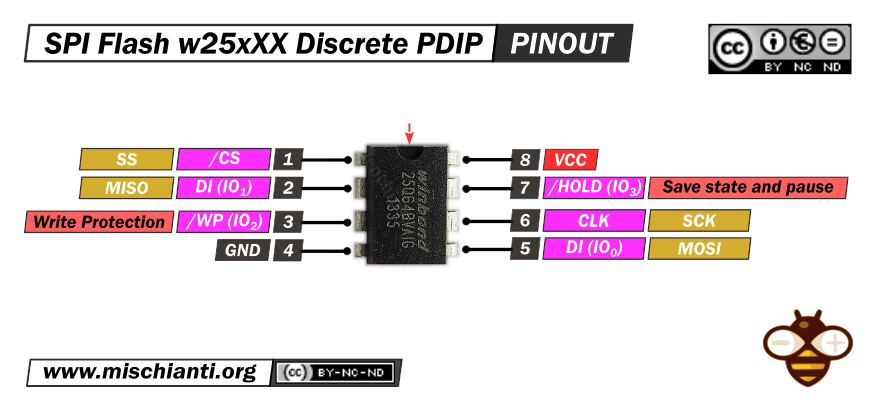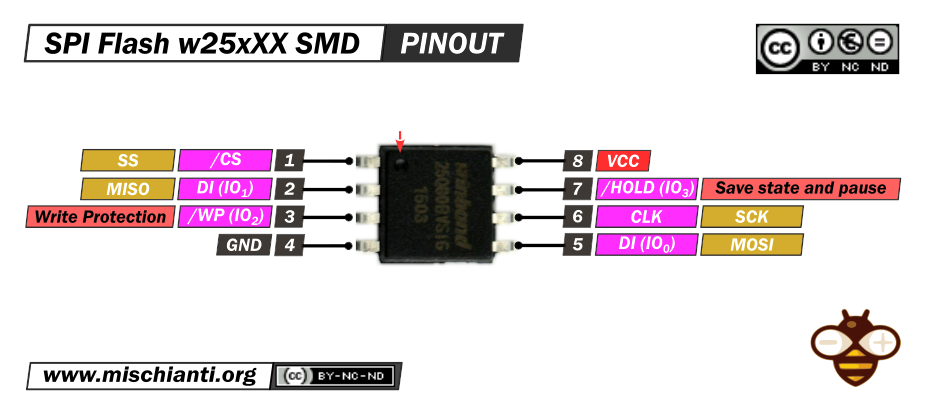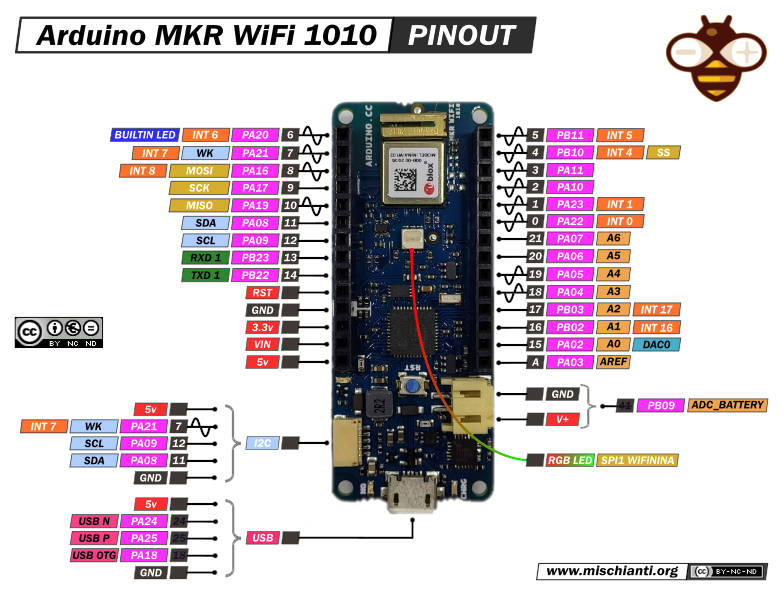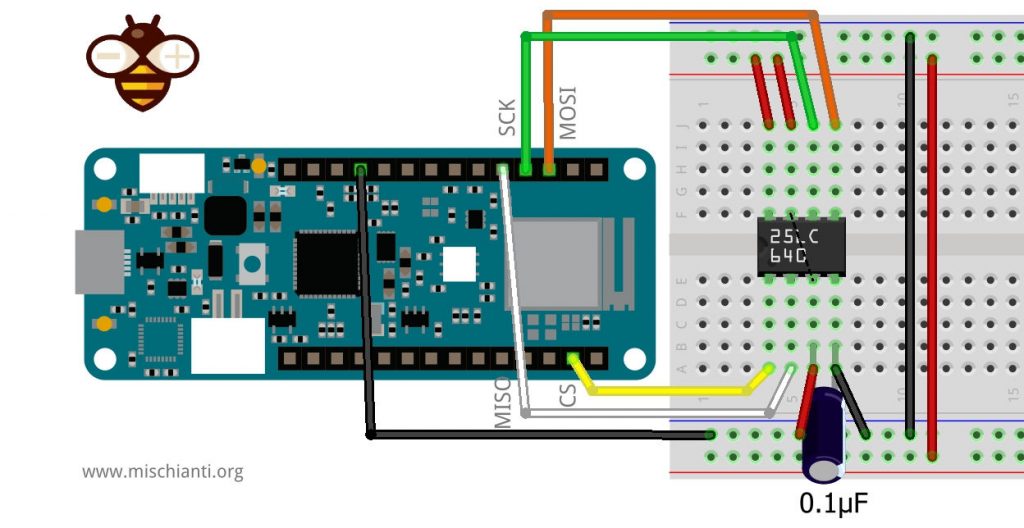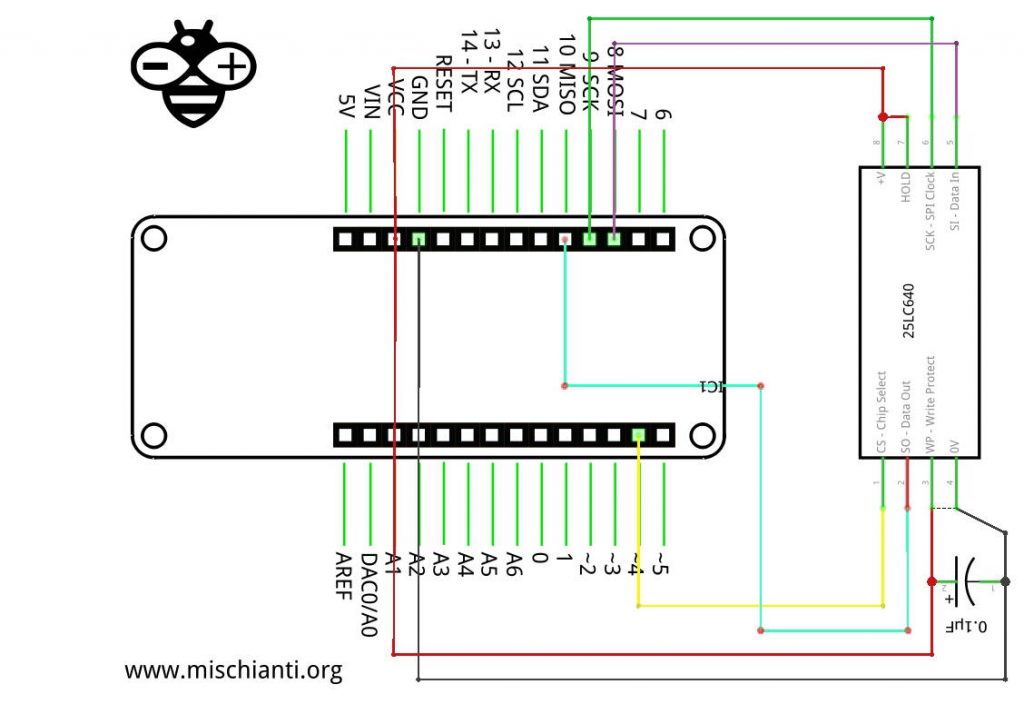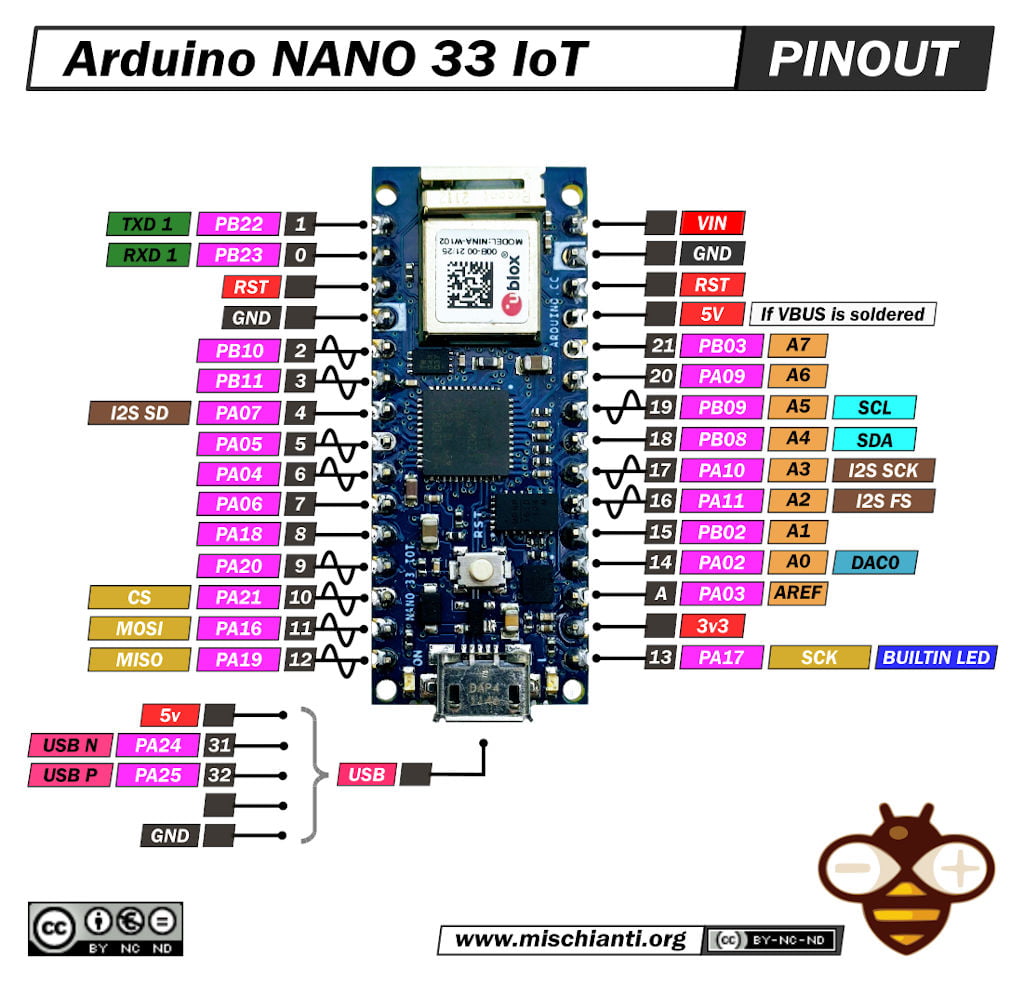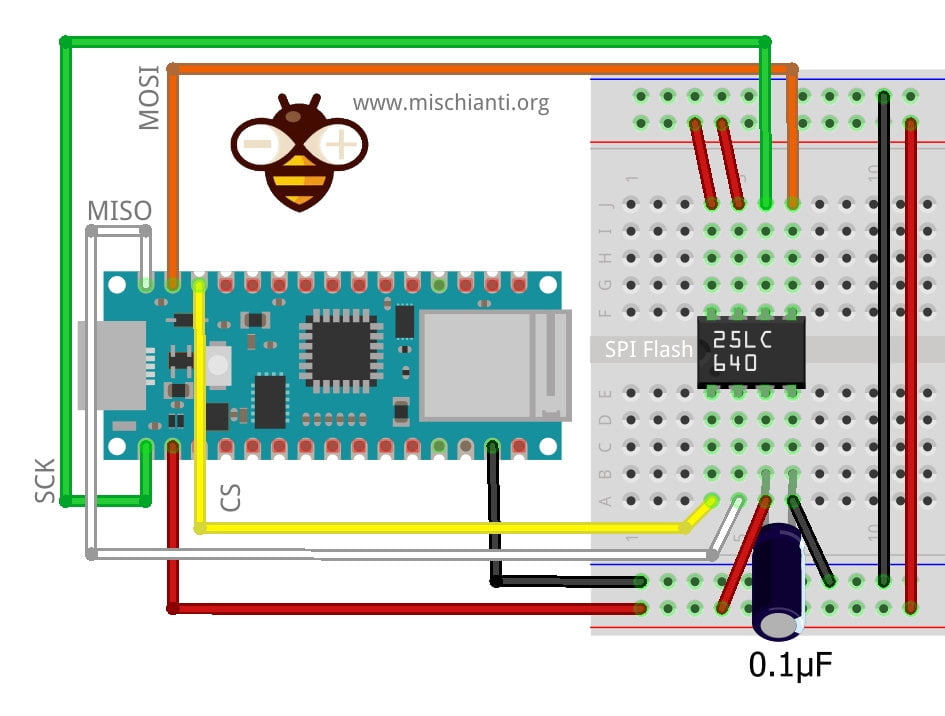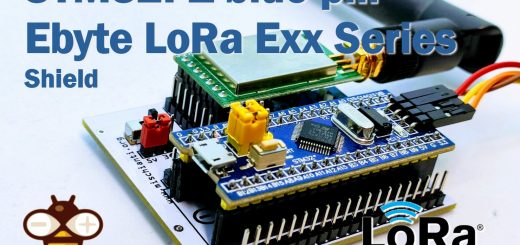Arduino SAMD (NANO 33 e MKR): file system FAT su memoria flash SPI esterna
I dispositivi Arduino SAMD non hanno una memoria flash SPI interna, ma è chiaro che una memoria veloce e piccola come quella può essere molto utile, quindi dobbiamo parlare ancora (e ancora e ancora e ancora e ancora…) di sistemi di archiviazione.
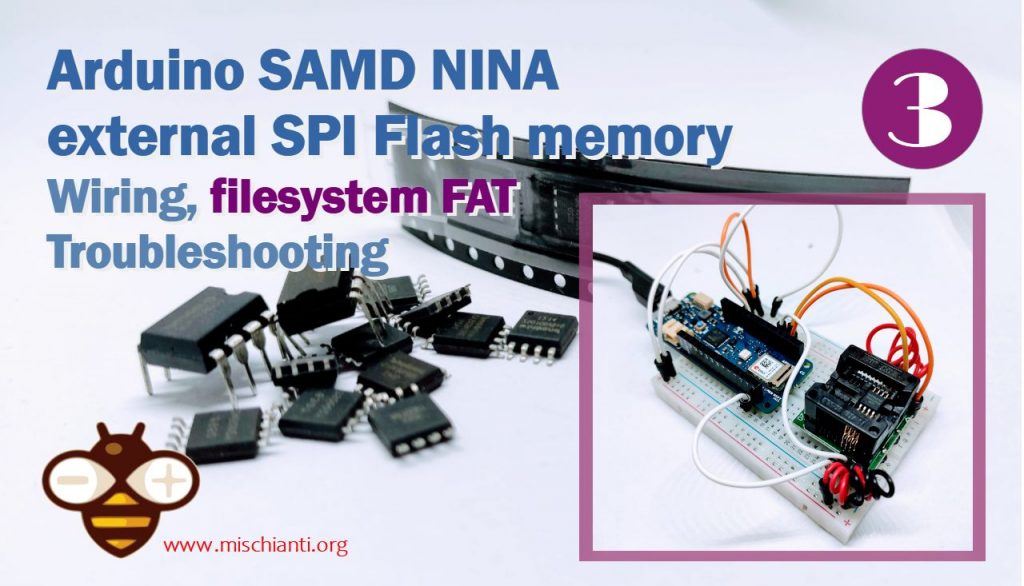
Avevamo già visto la gestione della SD (puoi vedere la gestione della SD su “Come usare la scheda SD con esp8266 e Arduino“), ora vorremmo guardare uno storage alternativo come la flash SPI esterna, simile alla EEPROM ma con la taglia più grande. La flash SPI ha una capacità inferiore ma è piccolo, veloce e ha un consumo energetico molto basso. L’SD È sicuramente la scelta migliore per dimensioni e compatibilità, ma queste caratteristiche le paghiamo con una buona quantità di energia.
Oggi vedremo la memoria flash SPI (NOR Flash); su un unico chip che può essere gestito tramite SPI e hanno accesso ad alta velocità e basso consumo energetico.
La memoria flash è un supporto di memoria elettronico non volatile per computer che può essere cancellato e riprogrammato elettricamente. I due tipi principali di memoria flash, NOR flash e NAND flash, prendono il nome dalle porte logiche NOR e NAND. La flash NAND e la flash NOR utilizzano lo stesso design delle celle, costituito da MOSFET a gate flottante. Differiscono a livello di circuito: nelle flash NAND, la relazione tra la linea di bit e le linee di parola assomiglia a una porta NAND; nelle flash NOR, assomiglia a un gate NOR; questo dipende dal fatto che lo stato della linea di bit o delle linee di parola sia HIGH o LOW.
Wikipedia
La memoria flash, un tipo di memoria a gate flottante, è stata inventata da Toshiba nel 1980 e si basa sulla tecnologia EEPROM. Toshiba ha iniziato a commercializzare memorie flash nel 1987. Le EPROM dovevano essere cancellate completamente prima di poter essere riscritte. La memoria flash NAND, tuttavia, può essere cancellata, scritta e letta in blocchi (o pagine), che generalmente sono molto più piccoli dell’intero dispositivo. La memoria flash NOR consente di scrivere una singola parola macchina – in una posizione cancellata – o di leggerla in modo indipendente. Un dispositivo di memoria flash è in genere costituito da uno o più chip di memoria flash (ciascuno contenente molte celle di memoria flash), insieme a un chip controller di memoria flash separato.
Memorie flash
Ci sono IC SMD e discreti gestiti dal protocollo SPI.
Qui un set di memorie flash di varie dimensioni w25q16 SMD 2Mb - w25q16 Discrete 2Mb - w25q32 SMD 4Mb - w25q32 Discrete 4Mb - w25q64 SMD 8Mb - w25q64 Discrete 8Mb - w25q128 SMD 16Mb - w25q128 Discrete 16Mb W25Q32 W25Q64 w25q128 module 4Mb 8Mb 16Mb
Schema elettrico Arduino MKR WiFi 1010
Puoi selezionare una SERCOM SPI su tutti i pin che desideri, ma ora utilizzeremo lo SPI standard.
Quindi puoi fare riferimento alla piedinatura e collegare i pin 8, 9, 10 e 4 per CS.
| Arduino | Flash SPI | |
|---|---|---|
| 4 | /CS | Pulled UP se non è un CS standard |
| 10 | DI (IO1) | |
| 8 | DI (IO0) | |
| 9 | CLK | |
| 3.3v | /WP | |
| 3.3v | /Hold | |
| GND | GND | |
| 3.3v | VCC |
Per il condensatore, io uso un 0.1μF e funziona correttamente, ma il valore standard era 0.01μF.
Schema elettrico Arduino NANO 33 IoT
Anche qui puoi selezionare una SERCOM SPI in tutti i pin che desideri, ma andremo ad utilizzare uno SPI standard.
Quindi puoi fare riferimento alla piedinatura e collegare i pin 11, 12, 13 e 10 per CS.
| Arduino | Flash SPI | |
|---|---|---|
| 10 | /CS | Pulled UP se non è uno standard CS |
| 12 | DI (IO1) | |
| 11 | DI (IO0) | |
| 13 | CLK | |
| 3.3v | /WP | |
| 3.3v | /Hold | |
| GND | GND | |
| 3.3v | VCC |
Per il condensatore, ho usato uno 0,1μF e funziona correttamente, ma il valore standard era 0,01μF.
Utilizzo di base di una flash SPI
Se non hai bisogno di una struttura di dati particolare, puoi fare un utilizzo di base e grezzo della flash SPI.
Per ulteriori informazioni su questa libreria, è possibile consultare l’articolo “Arduino: memoria SPI flash esterna veloce”.
Per un utilizzo di base, consiglio di utilizzare una libreria denominata SPIMemory, abbastanza semplice ma con un buon supporto senza difficoltà. Puoi scaricarla tramite il gestore della libreria da Arduino IDE.
È necessario bloccare le frequenze a 12Mhz per questo dispositivo perché l’interfaccia sercom non ne consente di più. Ma in teoria puoi aprire cinque diversi dispositivi SPI.
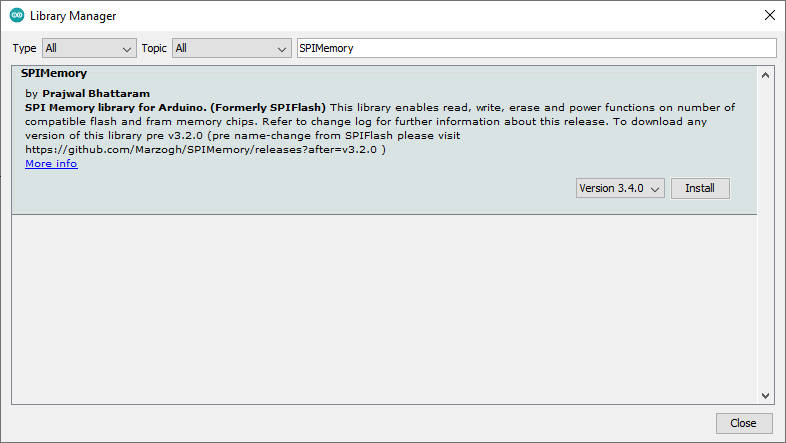
Ecco un semplice esempio che memorizza una stringa JSON nell’indirizzo iniziale 0 e la rileggo, quindi chiedo al metodo getAddress la prima posizione contigua disponibile in cui posso memorizzare un’altra stringa JSON, la salvo e la rileggo .
/*
* Manage external SPI Flash with Arduino
* Write and read a JSON structure like a String,
* find first address available
* and write and read another JSON structure
*
* with library SPIMemory
*
* by Mischianti Renzo <https://mischianti.org>
*
* https://mischianti.org/
*
* SPIFlash connected via SPI standard
*
*/
#include <SPIMemory.h>
#include <ArduinoJson.h>
//SPIFlash flash; // If you don't specify the library use standard SPI connection
SPIFlash flash(SS, &SPI);
void setup() {
Serial.begin(115200);
while (!Serial) ; // Wait for Serial monitor to open
delay(100);
flash.setClock(12000000); // uncomment here for Arduino SAMD boards
flash.begin(); // If SPIMemory isn't recognized you can specify the size of memory
// flash.eraseChip();
Serial.print(F("Flash size: "));
Serial.print((long)(flash.getCapacity()/1000));
Serial.println(F("Kb"));
unsigned long strAddr = 0;
unsigned long strAddrSecondString = 0;
Serial.println();
// Allocate a temporary JsonDocument
// Don't forget to change the capacity to match your requirements.
// Use arduinojson.org/v6/assistant to compute the capacity.
// StaticJsonDocument<512> doc;
// You can use DynamicJsonDocument as well
Serial.println(F("Generate JSON file!"));
DynamicJsonDocument doc(512);
// Set the values in the document
doc["energyLifetime"] = 21698620;
doc["energyYearly"] = 1363005;
Serial.print(F("Put data in a buffer.. "));
// Serialize JSON to file
String buf;
if (serializeJson(doc, buf) == 0) {
Serial.println(F("failed to write buffer"));
}
if (flash.writeStr(strAddr, buf)){
Serial.print(F("OK, writed on address "));
Serial.println(strAddr);
}else{
Serial.println(F("KO"));
}
String outputString = "";
if (flash.readStr(strAddr, outputString)) {
Serial.print(F("Read json: "));
Serial.println(outputString);
Serial.print(F("From address: "));
Serial.println(strAddr);
}
Serial.println(F("Generate JSON file!"));
DynamicJsonDocument doc2(512);
// Set the values in the document
doc2["energyLifetime"] = 222;
doc2["energyYearly"] = 333;
Serial.println();
Serial.print(F("Check first free sector: "));
strAddrSecondString = flash.getAddress(doc2.size());
Serial.println(strAddrSecondString);
Serial.println();
Serial.print(F("Stream data in flash memory!"));
Serial.print(F("Put data in a buffer.."));
// Serialize JSON to file
String buf2;
if (serializeJson(doc2, buf2) == 0) {
Serial.println(F("failed to write buffer"));
}
// Print test file
if (flash.writeStr(strAddrSecondString, buf2)){
Serial.print(F("OK, writed on address "));
Serial.println(strAddrSecondString);
}else{
Serial.println(F("KO"));
}
String outputString2 = "";
if (flash.readStr(strAddrSecondString, outputString2)) {
Serial.print(F("Read data: "));
Serial.println(outputString2);
Serial.print(F("From address: "));
Serial.println(strAddrSecondString);
}
while (!flash.eraseSector(strAddr));
while (!flash.eraseSector(strAddrSecondString));
}
void loop() {
}
Ecco il risultato della console.
Flash size: 8388Kb
Generate JSON file!
Put data in a buffer.. OK, writed on address 0
Read json: {"energyLifetime":21698620,"energyYearly":1363005}
From address: 0
Generate JSON file!
Check first free sector: 56
Stream data in flash memory!Put data in a buffer..OK, writed on address 56
Read data: {"energyLifetime":222,"energyYearly":333}
From address: 56
Uso avanzato di una Flash SPI con il filesystem SdFat
Una libreria più complessa (e più affamata di risorse) è quella di Adafruit, l’Adafruit SPIFlash, che deve essere usata con il fork di SdFat Adafruit.
Questa libreria è sconsigliata su schede Arduino come UNO o Mega perché, solo per il buffer, ha bisogno di 512 byte e ogni file ha qualche byte di preambolo e rischi di sprecare molta RAM.
Per un microcontrollore a bassa potenza, è meglio usare una libreria come SPIMemory.
Puoi trovare queste librerie anche sul gestore delle librerie “Adafruit SPIFlash” e “SdFat – Adafruit Fork”.
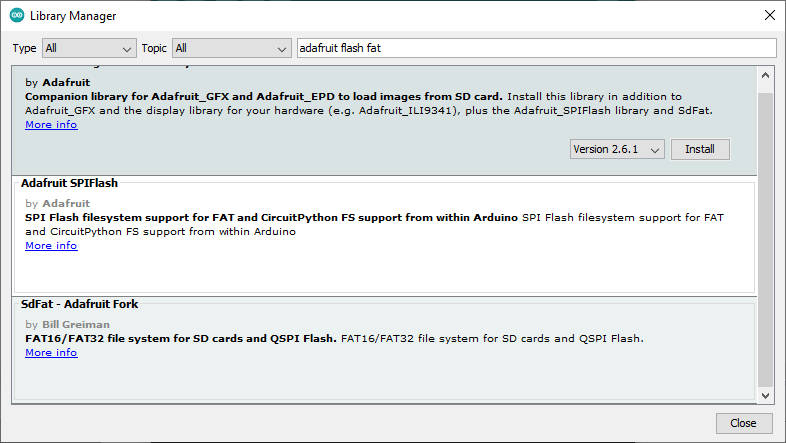
Aggiungere un nuovo tipo di flash SPI
Il set di chip supportato è limitato a un elenco specificato ma si può creare un nuovo dispositivo. Ad esempio, ho un W25X80AVAIZ (penso Winbond clone), un componente discreto che è possibile acquistare a un prezzo molto basso.
Ha queste caratteristiche:
- capacità 1Mb;
- 104 Mhz di velocità;
- clone di Winbond;
- SPI singolo doppio e quadruplo.
Ora, scrivo un semplice sketch per verificare la compatibilità:
/*
* Retrieve basic core info of Flash SPI
* Add a custom device w25x80
* library Adafruit_SPIFlash and SdFat - AdafruitFork
*
* by Mischianti Renzo <https://mischianti.org>
*
* https://mischianti.org/
*
* SPIFlash connected via SPI standard check wiring on the article
*
*/
#include "SdFat.h"
#include "Adafruit_SPIFlash.h"
Adafruit_FlashTransport_SPI flashTransport(SS, SPI); // Set CS and SPI interface
Adafruit_SPIFlash flash(&flashTransport);
void setup()
{
Serial.begin(115200);
while ( !Serial ) delay(100); // wait for native usb
if (flash.begin()) {
Serial.println(F("Device finded and supported!"));
} else {
Serial.println(F("Problem to discover and configure device, check wiring also!"));
}
// Set 4Mhz SPI speed
flashTransport.setClockSpeed(4000000, 4000000); // added to prevent speed problem
Serial.println();
Serial.println("Adafruit Serial Flash get basic info: ");
Serial.print("JEDEC ID (FFFFFF for unknown): "); Serial.println(flash.getJEDECID(), HEX);
Serial.print("Flash size: "); Serial.println(flash.size());
Serial.println();Serial.println();
uint8_t jedec_ids[4];
flashTransport.readCommand(SFLASH_CMD_READ_JEDEC_ID, jedec_ids, 4);
// For simplicity with commonly used device, we only check for continuation
// code at 2nd byte (e.g Fujitsu FRAM devices)
if (jedec_ids[1] == 0x7F) {
// Shift and skip continuation code in 2nd byte
jedec_ids[1] = jedec_ids[2];
jedec_ids[2] = jedec_ids[3];
}
Serial.println("Retrieve JDEC_ID");
Serial.print("Manufacturer ID: 0x");
Serial.println(jedec_ids[0], HEX);
Serial.print("Memory Type: 0x");
Serial.println(jedec_ids[1], HEX);
Serial.print("Capacity: 0x");
Serial.println(jedec_ids[2], HEX);
Serial.print("Capacity DEC: ");
Serial.println(jedec_ids[2], DEC);
}
void loop()
{
// nothing to do
}
L’uscita seriale per il mio dispositivo non supportato è:
Unknown flash device 0xEF4014
Problem to discover and configure device, check wiring also!
Adafruit Serial Flash get basic info:
JEDEC ID (FFFFFF for unknown): FFFFFF
Flash size: 0
Retrieve JDEC_ID
Manufacturer ID: 0xEF
Memory Type: 0x40
Capacity: 0x14
Capacity DEC: 20
Quindi prendo dalla libreria Adafruit_SPIFlash il file flash_devices.h e seleziono il dispositivo più simile nell’elenco.
Allora uso:
Capacity DEC per ottenere la dimensione: .total_size = (1UL << 20), /* 1 MiB */
Manufacturer ID per il produttore: .manufacturer_id = 0xef
Memory type per memory_type: .memory_type = 0x40
The Capacity per la capacità: .capacity = 0x14
Cerco di trovare alcune informazioni sulla scheda tecnica del dispositivo compatibile.
// Settings for the Winbond W25Q80BV (1 MiB SPI flash.)
// https://pdf1.alldatasheet.com/datasheet-pdf/view/555565/WINBOND/W25Q80BV.html
#define W25X80BV \
{ \
.total_size = (1UL << 20), /* 1 MiB */ \
.start_up_time_us = 5000, .manufacturer_id = 0xef, \
.memory_type = 0x40, .capacity = 0x14, .max_clock_speed_mhz = 104, \
.quad_enable_bit_mask = 0x02, .has_sector_protection = false, \
.supports_fast_read = true, .supports_qspi = true, \
.supports_qspi_writes = true, .write_status_register_split = false, \
.single_status_byte = false, .is_fram = false, \
}
static const SPIFlash_Device_t possible_devices[] = {
W25X80BV,
};
// Initialize flash library and check its chip ID.
if (!flash.begin(possible_devices)) {
Serial.println("Error, failed to initialize flash chip!");
while(1) yield();
}
Ora lo sketch di prova completo diventa:
/*
* Retrieve basic core info of Flash SPI
* Add a custom device w25x80
* library Adafruit_SPIFlash and SdFat - AdafruitFork
*
* by Mischianti Renzo <https://mischianti.org>
*
* https://mischianti.org/
*
* SPIFlash connected via SPI standard check wiring on the article
*
*/
#include "SdFat.h"
#include "Adafruit_SPIFlash.h"
Adafruit_FlashTransport_SPI flashTransport(SS, SPI); // Set CS and SPI interface
Adafruit_SPIFlash flash(&flashTransport);
void setup()
{
Serial.begin(115200);
while ( !Serial ) delay(100); // wait for native usb
// Settings for the Winbond W25Q80BV (1 MiB SPI flash.)
// https://pdf1.alldatasheet.com/datasheet-pdf/view/555565/WINBOND/W25Q80BV.html
#define W25X80BV \
{ \
.total_size = (1UL << 20), /* 1 MiB */ \
.start_up_time_us = 5000, .manufacturer_id = 0xef, \
.memory_type = 0x40, .capacity = 0x14, .max_clock_speed_mhz = 104, \
.quad_enable_bit_mask = 0x02, .has_sector_protection = false, \
.supports_fast_read = true, .supports_qspi = true, \
.supports_qspi_writes = true, .write_status_register_split = false, \
.single_status_byte = false, .is_fram = false, \
}
static const SPIFlash_Device_t possible_devices[] = {
W25X80BV,
};
if (flash.begin(possible_devices)) {
Serial.println(F("Device finded and supported!"));
} else {
Serial.println(F("Problem to discover and configure device, check wiring also!"));
}
// Set 4Mhz SPI speed
flashTransport.setClockSpeed(4000000, 4000000); // added to prevent speed problem
Serial.println();
Serial.println("Adafruit Serial Flash get basic info: ");
Serial.print("JEDEC ID (FFFFFF for unknown): "); Serial.println(flash.getJEDECID(), HEX);
Serial.print("Flash size: "); Serial.println(flash.size());
Serial.println();Serial.println();
uint8_t jedec_ids[4];
flashTransport.readCommand(SFLASH_CMD_READ_JEDEC_ID, jedec_ids, 4);
// For simplicity with commonly used device, we only check for continuation
// code at 2nd byte (e.g Fujitsu FRAM devices)
if (jedec_ids[1] == 0x7F) {
// Shift and skip continuation code in 2nd byte
jedec_ids[1] = jedec_ids[2];
jedec_ids[2] = jedec_ids[3];
}
Serial.println("Retrieve JDEC_ID");
Serial.print("Manufacturer ID: 0x");
Serial.println(jedec_ids[0], HEX);
Serial.print("Memory Type: 0x");
Serial.println(jedec_ids[1], HEX);
Serial.print("Capacity: 0x");
Serial.println(jedec_ids[2], HEX);
Serial.print("Capacity DEC: ");
Serial.println(jedec_ids[2], DEC);
}
void loop()
{
// nothing to do
}
E ora il risultato è:
Device finded and supported!
Adafruit Serial Flash get basic info:
JEDEC ID (FFFFFF for unknown): EF4014
Flash size: 1048576
Retrieve JDEC_ID
Manufacturer ID: 0xEF
Memory Type: 0x40
Capacity: 0x14
Capacity DEC: 20
Test e risoluzione dei problemi
Per verificare se tutto è a posto, puoi utilizzare il test fornito in libreria. Innanzitutto, devi avviare l’esempio SdFat_speedtest; per Arduino UNO, come la scheda con poca RAM, è necessario ridurre il buffer da
#define BUFSIZE 4096
a
#define BUFSIZE 512
ecco lo sketch completo con l’IC personalizzato:
// The MIT License (MIT)
// Copyright (c) 2019 Ha Thach for Adafruit Industries
#include "SdFat.h"
#include "Adafruit_SPIFlash.h"
// Uncomment to run example with custom SPI and SS e.g with FRAM breakout
#define CUSTOM_CS SS
#define CUSTOM_SPI SPI
#define EXTERNAL_FLASH_USE_QSPI
Adafruit_FlashTransport_SPI flashTransport(CUSTOM_CS, CUSTOM_SPI);
Adafruit_SPIFlash flash(&flashTransport);
#define BUFSIZE 4096
// 4 byte aligned buffer has best result with nRF QSPI
uint8_t bufwrite[BUFSIZE] __attribute__ ((aligned(4)));
uint8_t bufread[BUFSIZE] __attribute__ ((aligned(4)));
// the setup function runs once when you press reset or power the board
void setup()
{
Serial.begin(115200);
while ( !Serial ) delay(100); // wait for native usb
// SPI.setFrequency(12000000);
// Settings for the Winbond W25Q80BV (1 MiB SPI flash.)
// https://pdf1.alldatasheet.com/datasheet-pdf/view/555565/WINBOND/W25Q80BV.html
#define W25X80BV \
{ \
.total_size = (1UL << 20), /* 1 MiB */ \
.start_up_time_us = 5000, .manufacturer_id = 0xef, \
.memory_type = 0x40, .capacity = 0x14, .max_clock_speed_mhz = 104, \
.quad_enable_bit_mask = 0x02, .has_sector_protection = false, \
.supports_fast_read = true, .supports_qspi = true, \
.supports_qspi_writes = true, .write_status_register_split = false, \
.single_status_byte = false, .is_fram = false, \
}
/// List of all possible flash devices used by Adafruit boards
static const SPIFlash_Device_t possible_devices[] = {
// Main devices used in current Adafruit products
W25X80BV,
};
// flash.begin(possible_devices); // custom board
flash.begin(); // start with standard board
pinMode(LED_BUILTIN, OUTPUT);
flash.setIndicator(LED_BUILTIN, true);
Serial.println("Adafruit Serial Flash Speed Test example");
Serial.print("JEDEC ID: "); Serial.println(flash.getJEDECID(), HEX);
Serial.print("Flash size: "); Serial.println(flash.size());
Serial.flush();
write_and_compare(0xAA);
write_and_compare(0x55);
Serial.println("Speed test is completed.");
Serial.flush();
}
void print_speed(const char* text, uint32_t count, uint32_t ms)
{
Serial.print(text);
Serial.print(count);
Serial.print(" bytes in ");
Serial.print(ms / 1000.0F, 2);
Serial.println(" seconds.");
Serial.print("Speed : ");
Serial.print( (count / 1000.0F) / (ms / 1000.0F), 2);
Serial.println(" KB/s.\r\n");
}
bool write_and_compare(uint8_t pattern)
{
uint32_t ms;
Serial.println("Erase chip");
Serial.flush();
#define TEST_WHOLE_CHIP
#ifdef TEST_WHOLE_CHIP
uint32_t const flash_sz = flash.size();
flash.eraseChip();
#else
uint32_t const flash_sz = 4096;
flash.eraseSector(0);
#endif
flash.waitUntilReady();
// write all
memset(bufwrite, (int) pattern, sizeof(bufwrite));
Serial.printf("Write flash with 0x%02X\n", pattern);
Serial.flush();
ms = millis();
for(uint32_t addr = 0; addr < flash_sz; addr += sizeof(bufwrite))
{
flash.writeBuffer(addr, bufwrite, sizeof(bufwrite));
}
uint32_t ms_write = millis() - ms;
print_speed("Write ", flash_sz, ms_write);
Serial.flush();
// read and compare
Serial.println("Read flash and compare");
Serial.flush();
uint32_t ms_read = 0;
for(uint32_t addr = 0; addr < flash_sz; addr += sizeof(bufread))
{
memset(bufread, 0, sizeof(bufread));
ms = millis();
flash.readBuffer(addr, bufread, sizeof(bufread));
ms_read += millis() - ms;
if ( memcmp(bufwrite, bufread, BUFSIZE) )
{
Serial.printf("Error: flash contents mismatched at address 0x%08X!!!", addr);
for(uint32_t i=0; i<sizeof(bufread); i++)
{
if ( i != 0 ) Serial.print(' ');
if ( (i%16 == 0) )
{
Serial.println();
Serial.printf("%03X: ", i);
}
Serial.printf("%02X", bufread[i]);
}
Serial.println();
return false;
}
}
print_speed("Read ", flash_sz, ms_read);
Serial.flush();
return true;
}
void loop()
{
// nothing to do
}
Se hai un output Serial come questo (io uso […] per indicare la replica della linea):
Adafruit Serial Flash Speed Test example
JEDEC ID: EF4014
Flash size: 1048576
Erase chip
Write flash with 0xAA
Write 1048576 bytes in 1.03 seconds.
Speed : 1016.06 KB/s.
Read flash and compare
Error: flash contents mismatched at address 0x00000000!!!
000: 00 00 00 00 00 00 00 00 00 00 00 00 00 00 00 00
[...]
FF0: 00 00 00 00 00 00 00 00 00 00 00 00 00 00 00 00
Erase chip
Write flash with 0x55
Write 1048576 bytes in 1.03 seconds.
Speed : 1017.05 KB/s.
Read flash and compare
Error: flash contents mismatched at address 0x00000000!!!
000: 00 00 00 00 00 00 00 00 00 00 00 00 00 00 00 00
[...]
FF0: 00 00 00 00 00 00 00 00 00 00 00 00 00 00 00 00
Speed test is completed.
Le righe (o altri caratteri esadecimali) con
000: 00 00 00 00 00 00 00 00 00 00 00 00 00 00 00 00
indica che i dati confrontati non corrispondono , quindi (se lo schizzo di prova precedente funziona) probabilmente hai avuto qualche problema.
Nella maggior parte dei casi, la velocità dello SPI è troppo alta; questo non significa che la velocità sia troppo alta per il microcontrollore o IC, ma può essere un problema con un cavo di connessione scadente.
Arduino MKR SAMD è supportato molto bene da questa libreria, quindi non devi fare nulla. Vedremo meglio nel prossimo paragrafo.
Ma se la soluzione fosse stata ridurre la velocità devi aggiungere una riga come questa dopo flash.begin():
flashTransport.setClockSpeed(24000000, 24000000);
il comando imposta la velocità SPI a 24 Mhz, e ora il risultato diventa così:
Adafruit Serial Flash Speed Test example
JEDEC ID: EF4014
Flash size: 1048576
Erase chip
Write flash with 0xAA
Write 1048576 bytes in 4.07 seconds.
Speed : 257.38 KB/s.
Read flash and compare
Read 1048576 bytes in 0.47 seconds.
Speed : 2226.28 KB/s.
Erase chip
Write flash with 0x55
Write 1048576 bytes in 4.07 seconds.
Speed : 257.38 KB/s.
Read flash and compare
Read 1048576 bytes in 0.47 seconds.
Speed : 2231.01 KB/s.
Speed test is completed.
Se non vengono visualizzati errori di confronto, la flash SPI è stata configurata correttamente.
Limitazioni degli Arduino SAMD
Per i dispositivi Arduino SAMD, la libreria blocca internamente la velocità massima a 12MHz, che è il limite dell’interfaccia sercom, ma puoi creare tutte le connessioni SPI che desideri.
#if defined(ARDUINO_ARCH_SAMD) && !defined(__SAMD51__)
// Hand-on testing show that SAMD21 M0 can write up to 24 Mhz,
// but can only read reliably at 12 Mhz
rd_speed = min(12000000, rd_speed);
#endif
Sketch pratico
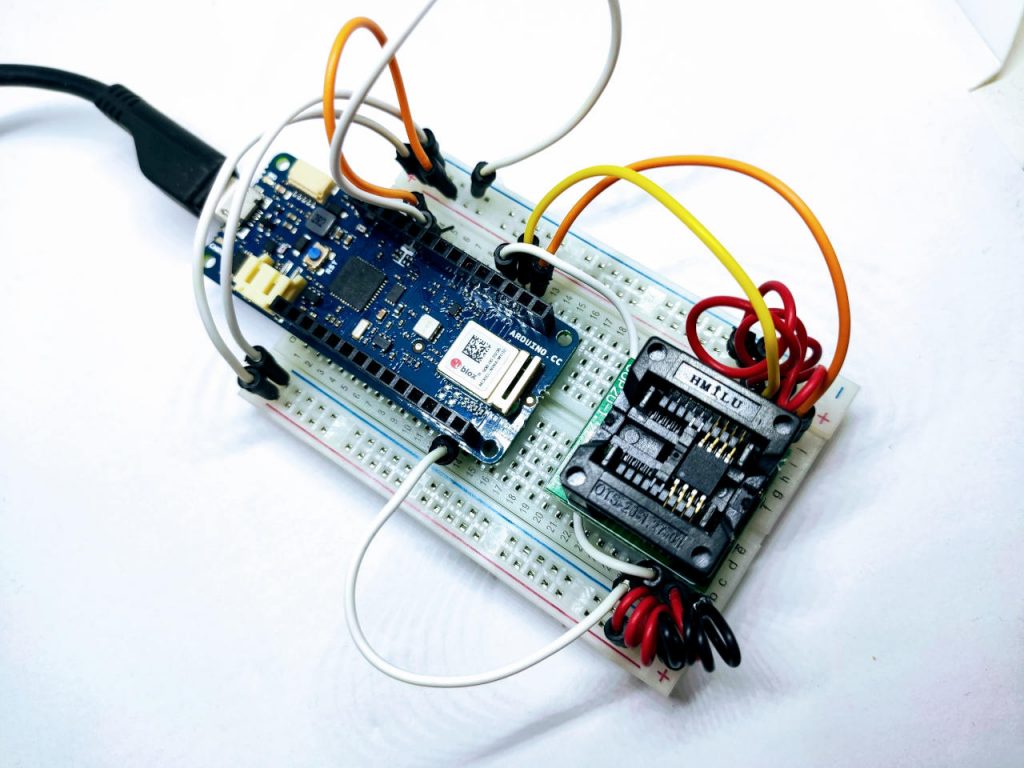
Prima di tutto, devi formattare la flash SPI; negli esempi di Adafruit_SPIFlash, puoi trovare l’ esempio SdFat_format, che formatta la flash SPI per te.
Quando avvii lo sketch, ti chiede di inserire, nel monitor Serial, “OK” in maiuscolo, ecco il risultato dell’output seriale.
Adafruit SPI Flash FatFs Format Example
Flash size: 1024 KB
Flash chip JEDEC ID: 0xEF4014
!!!!!!!!!!!!!!!!!!!!!!!!!!!!!!!!!!!!!!!!!!!!!!!!!!!!!!!!!!!!!!!!!!!!!
This sketch will ERASE ALL DATA on the flash chip and format it with a new filesystem!
Type OK (all caps) and press enter to continue.
!!!!!!!!!!!!!!!!!!!!!!!!!!!!!!!!!!!!!!!!!!!!!!!!!!!!!!!!!!!!!!!!!!!!!
>>Send to COM17: "OK"<<
Creating and formatting FAT filesystem (this takes ~60 seconds)...
Setting disk label to: EXT FLASH
Formatted flash!
Flash chip successfully formatted with new empty filesystem!
Ora sei pronto per utilizzare la flash SPI con FAT FS.
Se vuoi usare il file system FAT, ti consiglio di usare una flash SPI con più di 1Mb di spazio.
Ecco un semplice sketch che crea un file test.txt con la stringa <num> -> testing 1, 2, 3. 100 volte.
/*
* Add new txt file and add the string <num> -> testing 1, 2, 3. 100 times
* than read the file and put on serial output.
* library Adafruit_SPIFlash and SdFat - AdafruitFork
*
* by Mischianti Renzo <https://mischianti.org>
*
* https://mischianti.org/
*
* SPIFlash connected via SPI standard check wiring on the article
*
*/
#include "SdFat.h"
#include "Adafruit_SPIFlash.h"
Adafruit_FlashTransport_SPI flashTransport(SS, SPI); // Set CS and SPI interface
Adafruit_SPIFlash flash(&flashTransport);
// file system object from SdFat
FatFileSystem fatfs;
File myFile;
void setup()
{
Serial.begin(115200);
while ( !Serial ) delay(100); // wait for native usb
// // Settings for the Winbond W25Q80BV (1 MiB SPI flash.)
// // https://pdf1.alldatasheet.com/datasheet-pdf/view/555565/WINBOND/W25Q80BV.html
// #define W25X80BV \
// { \
// .total_size = (1UL << 20), /* 1 MiB */ \
// .start_up_time_us = 5000, .manufacturer_id = 0xef, \
// .memory_type = 0x40, .capacity = 0x14, .max_clock_speed_mhz = 104, \
// .quad_enable_bit_mask = 0x02, .has_sector_protection = false, \
// .supports_fast_read = true, .supports_qspi = true, \
// .supports_qspi_writes = true, .write_status_register_split = false, \
// .single_status_byte = false, .is_fram = false, \
// }
//
//
// /// List of all possible flash devices used by Adafruit boards
// static const SPIFlash_Device_t possible_devices[] = {
// // Main devices used in current Adafruit products
// W25X80BV,
// };
//if (flash.begin(possible_devices)) {
if (flash.begin()) {
Serial.println(F("Device finded and supported!"));
} else {
Serial.println(F("Problem to discover and configure device, check wiring also!"));
}
// Set 24Mhz SPI speed
// flashTransport.setClockSpeed(24000000, 24000000); // added to prevent speed problem
pinMode(LED_BUILTIN, OUTPUT);
flash.setIndicator(LED_BUILTIN, true);
Serial.println("Adafruit Serial Flash read write example");
Serial.print("JEDEC ID: "); Serial.println(flash.getJEDECID(), HEX);
Serial.print("Flash size: "); Serial.println(flash.size());
Serial.flush();
Serial.println();
// First call begin to mount the filesystem. Check that it returns true
// to make sure the filesystem was mounted.
if (!fatfs.begin(&flash)) {
Serial.println("Error, failed to mount newly formatted filesystem!");
Serial.println("Was the flash chip formatted with the SdFat_format example?");
while(1) yield();
}
Serial.println("Mounted filesystem!");
Serial.println();
// open the file. note that only one file can be open at a time,
// so you have to close this one before opening another.
myFile = fatfs.open("test.txt", FILE_WRITE);
// if the file opened okay, write to it:
if (myFile) {
Serial.print("Writing to test.txt...");
for (int i=0;i<100;i++){
myFile.print(i);
myFile.println(" -> testing 1, 2, 3.");
}
// close the file:
myFile.close();
Serial.println("done.");
} else {
// if the file didn't open, print an error:
Serial.println("error opening test.txt");
}
// re-open the file for reading:
myFile = fatfs.open("test.txt");
if (myFile) {
Serial.println("test.txt:");
// read from the file until there's nothing else in it:
while (myFile.available()) {
Serial.write(myFile.read());
}
// close the file:
myFile.close();
} else {
// if the file didn't open, print an error:
Serial.println("error opening test.txt");
}
}
void loop() {
// nothing happens after setup
}
Il risultato sarà così:
Device finded and supported!
Adafruit Serial Flash Speed Test example
JEDEC ID: EF4017
Flash size: 8388608
Mounted filesystem!
Writing to test.txt...done.
test.txt:
0 -> testing 1, 2, 3.
[...]
99 -> testing 1, 2, 3.
ets Jun 8 2016 00:22:57
Ora possiamo chiamare alcuni comandi per recuperare le informazioni sul filesystem e quindi ottenere l’elenco dei file con il comando ls.
/*
* Retrieve basic core info of Flash SPI
* Get size and free size
*
* than call ls command
*
* library Adafruit_SPIFlash and SdFat - AdafruitFork
*
* by Mischianti Renzo <https://mischianti.org>
*
* https://mischianti.org/
*
* SPIFlash connected via SPI standard check wiring on the article
*
*/
#include "SdFat.h"
#include "Adafruit_SPIFlash.h"
Adafruit_FlashTransport_SPI flashTransport(SS, SPI); // Set CS and SPI interface
Adafruit_SPIFlash flash(&flashTransport);
// file system object from SdFat
FatFileSystem fatfs;
void setup()
{
Serial.begin(115200);
while ( !Serial ) delay(100); // wait for native usb
// // Settings for the Winbond W25Q80BV (1 MiB SPI flash.)
// // https://pdf1.alldatasheet.com/datasheet-pdf/view/555565/WINBOND/W25Q80BV.html
// #define W25X80BV \
// { \
// .total_size = (1UL << 20), /* 1 MiB */ \
// .start_up_time_us = 5000, .manufacturer_id = 0xef, \
// .memory_type = 0x40, .capacity = 0x14, .max_clock_speed_mhz = 104, \
// .quad_enable_bit_mask = 0x02, .has_sector_protection = false, \
// .supports_fast_read = true, .supports_qspi = true, \
// .supports_qspi_writes = true, .write_status_register_split = false, \
// .single_status_byte = false, .is_fram = false, \
// }
//
//
// /// List of all possible flash devices used by Adafruit boards
// static const SPIFlash_Device_t possible_devices[] = {
// // Main devices used in current Adafruit products
// W25X80BV,
// };
//if (flash.begin(possible_devices)) {
if (flash.begin()) {
Serial.println(F("Device finded and supported!"));
} else {
Serial.println(F("Problem to discover and configure device, check wiring also!"));
}
// Set 24Mhz SPI speed
// flashTransport.setClockSpeed(24000000, 24000000); // added to prevent speed problem
pinMode(LED_BUILTIN, OUTPUT);
flash.setIndicator(LED_BUILTIN, true);
Serial.println("Adafruit Serial Flash Speed Test example");
Serial.print("JEDEC ID: "); Serial.println(flash.getJEDECID(), HEX);
Serial.print("Flash size: "); Serial.println(flash.size());
Serial.flush();
Serial.println();
// First call begin to mount the filesystem. Check that it returns true
// to make sure the filesystem was mounted.
if (!fatfs.begin(&flash)) {
Serial.println("Error, failed to mount newly formatted filesystem!");
Serial.println("Was the flash chip formatted with the SdFat_format example?");
while(1) yield();
}
Serial.println("Mounted filesystem!");
Serial.println();
Serial.print("Clusters: ");
Serial.println(fatfs.clusterCount());
Serial.print("Blocks x Cluster: ");
Serial.println(fatfs.blocksPerCluster());
Serial.print("Total Blocks: ");
Serial.println(fatfs.blocksPerCluster() * fatfs.clusterCount());
Serial.println();
// print the type and size of the first FAT-type volume
uint32_t volumesize;
Serial.print("Volume type is: FAT");
Serial.println(fatfs.fatType(), DEC);
volumesize = fatfs.blocksPerCluster(); // clusters are collections of blocks
volumesize *= fatfs.clusterCount(); // we'll have a lot of clusters
volumesize /= 2; // SD card blocks are always 512 bytes (2 blocks are 1KB)
Serial.print("Volume size (Kb): ");
Serial.println(volumesize);
Serial.print("Volume size (Mb): ");
volumesize /= 1024;
Serial.println(volumesize);
Serial.println();
// print the type and size of the first FAT-type volume
volumesize = 0;
volumesize = fatfs.blocksPerCluster(); // clusters are collections of blocks
volumesize *= fatfs.freeClusterCount(); // we'll have a lot of clusters
volumesize /= 2; // SD card blocks are always 512 bytes (2 blocks are 1KB)
Serial.print("Free space size (Kb): ");
Serial.println(volumesize);
Serial.print("Free space size (Mb): ");
volumesize /= 1024;
Serial.println(volumesize);
Serial.println("\nFiles found on the card (name, date and size in bytes): ");
fatfs.rootDirStart();
// list all files in the card with date and size
fatfs.ls(LS_R | LS_DATE | LS_SIZE);
}
void loop(void) {
}
Il risultato sarà
Device finded and supported!
Adafruit Serial Flash Speed Test example
JEDEC ID: EF4017
Flash size: 8388608
Mounted filesystem!
Clusters: 2043
Blocks x Cluster: 8
Total Blocks: 16344
Volume type is: FAT12
Volume size (Kb): 8172
Volume size (Mb): 7
Free space size (Kb): 8164
Free space size (Mb): 7
Files found on the card (name, date and size in bytes):
2000-01-01 01:00:00 7170 test.txt
Grazie
- Arduino SAMD NINA: piedinatura, specifiche e configurazione Arduino IDE
- Arduino SAMD NINA: WiFiNINA, aggiornamento firmware e led RGB
- Arduino SAMD (NANO 33 e MKR): file system FAT su memoria flash SPI esterna
- i2c Arduino SAMD MKR: interfaccia aggiuntiva SERCOM, rete e scanner di indirizzi
- Arduino MKR SAMD: file system FAT su memoria flash SPI esterna
- Collegamento dell’EByte E70 ai dispositivi Arduino SAMD (Nano 33, MKR…) e un semplice sketch di esempio

